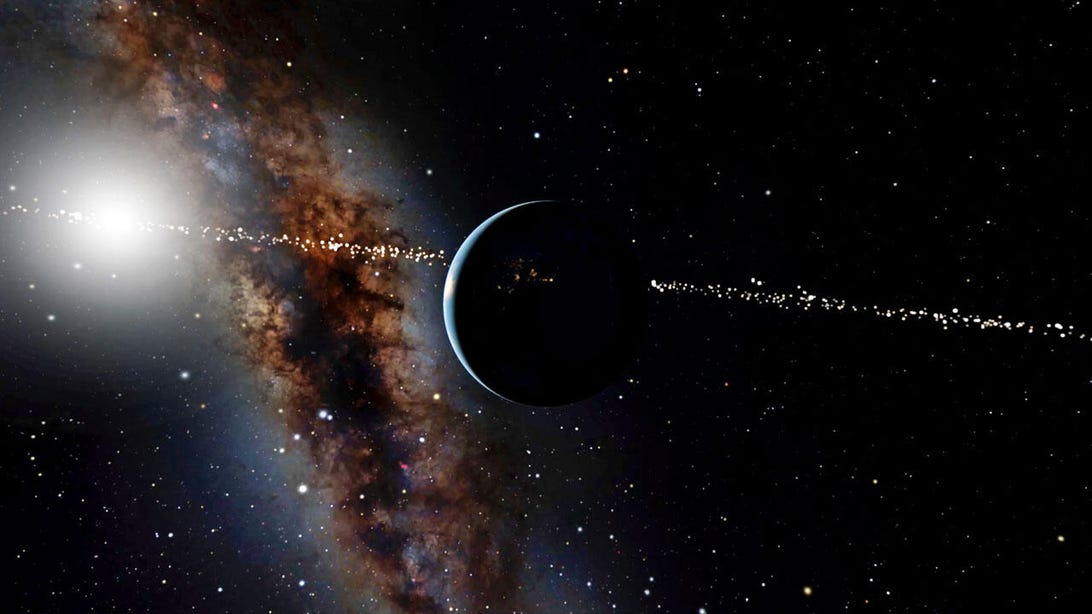
A view of Earth and the sun from thousands of miles above our planet. Stars that enter and exit a position where they can see Earth as a transiting planet around our sun are brightened.
OpenSpace/American Museum of Natural HistoryScientists have been scanning the cosmos for possible signals from alien civilizations for decades, but for over a century, humans have also been sending out signals from Earth that could be picked up by aliens beyond our planet.
That is, if they're looking in the right place for us.
Now, new research has determined exactly which star systems have been -- or will be -- in a position to spot Earth and mark it as a potential home to intelligent life worth investigating further (or perhaps avoiding altogether).
"Any civilization with our level of technology could have seen us already," Cornell astronomy professor Lisa Kaltenegger told me via email.
Kaltenegger and astrophysicist Jackie Faherty, from the American Museum of Natural History, used data from the European Space Agency's Gaia space observatory to identify 2,034 nearby systems with promising perches for scoping out some human aliens.
"We wanted to know which stars have the right vantage point to see Earth, as it blocks the sun's light," she said. "And because stars move in our dynamic cosmos, this vantage point is gained and lost. I was wondering how long that front row seat to find Earth through the dip in brightness of the star lasts. No one knew. "
Kaltenegger and Faherty tapped the latest, extensive Gaia star catalog, which contains both the positions and motion of stars, to find answers.
"So, you can spin their movement into the future and trace it back into the past," Kaltenegger explains.
What they found is 1,715 of the star systems have been in the right position to have spotted Earth passing in front of, or transiting, the sun since human civilization got going about 5,000 years ago. The other 319 systems will move into a position with a line of sight to Earth over the next 5,000 years.
In a paper published online Wednesday by the journal Nature, the scientists further zoom in on 75 systems that have been in that ideal human-spotting range, called the Earth Transit Zone, since commercial radio stations began sending broadcast signals into space that travel outwards into the cosmos at the speed of light.
So if someone or something in those systems is operating a radio telescope like one of ours, they might already being enjoying some seriously old-fashioned radio dramas from Earth right now.
"Our analysis shows that even the closest stars generally spend more than 1,000 years at a vantage point from which they can see Earth transit," the paper reads. "That provides a long timeline for nominal civilizations to identify Earth as an interesting planet."
The scientists also identify seven of the 2,034 star systems that are known to host exoplanets. These include Ross 128, a red dwarf star only 11 light-years away that is orbited by an Earth-sized planet. The world would have had a view of Earth starting a little over 3,000 years ago, but it moved out of the observing zone about 900 years ago.
"Would anyone have concluded that there was intelligent life on Earth 900 years ago?" Kaltenegger wonders.
The Trappist-1 system is only 45 light years from us and hosts a whopping seven Earth-size planets, including four in the habitable zone, but they probably aren't spying on us. At least not yet -- their path will move them into the Earth Transit Zone where they could observe us, but not for 1,642 years.
Three star systems host exoplanets that should be able to view Earth right now and for hundreds of years to come, but all of them are over 200 light-years away, meaning our commercial radio signals haven't reached them yet.
On the scale of the entire Milky Way galaxy, this is still practically next door. The researchers hope that their work will help inform science using exciting new tech that's just around the corner like the upcoming James Webb Telescope or Breakthrough Starshot's plan to send a tiny spacecraft to check out the Alpha Centauri system and its known exoplanet just 4.2 light years away.
"One might imagine that worlds beyond Earth that have already detected us, are making the same plans for our planet and solar system," Faherty said. "This catalog is an intriguing thought experiment for which one of our neighbors might be able to find us."
Follow CNET's 2021 Space Calendar to stay up to date with all the latest space news this year. You can even add it to your own Google Calendar.
"Give" - Google News
June 23, 2021 at 10:00PM
https://ift.tt/3j6iVJR
Scientists list the stars that give aliens the best view of Earth - CNET
"Give" - Google News
https://ift.tt/2YqGX80
https://ift.tt/2YquBwx
Bagikan Berita Ini














0 Response to "Scientists list the stars that give aliens the best view of Earth - CNET"
Post a Comment